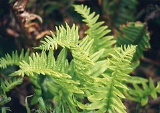
Polypodiales
Encyclopedia
The order Polypodiales encompasses the major lineages of polypod fern
s, which comprise more than 80% of today's fern species. They are found in many parts of the world including tropical, semitropical and temperate areas. The characteristics of this group include: sporangia with a vertical annulus interrupted by the stalk and stomium; indusia laterally or centrally attached (or lost); gametophytes green, chordate, and surficial
.
Polypodiales may be regarded as one of the most evolution
arily advanced orders of monilophytes (ferns), based on recent genetic analysis. They arose and diversified about 100 million years ago, probably subsequent to the diversification of the angiosperms.
The 15 families of Polypodiales are listed here from those considered most basal
to those considered most derived
Now-obsolete families of Polypodiales:
Fern
A fern is any one of a group of about 12,000 species of plants belonging to the botanical group known as Pteridophyta. Unlike mosses, they have xylem and phloem . They have stems, leaves, and roots like other vascular plants...
s, which comprise more than 80% of today's fern species. They are found in many parts of the world including tropical, semitropical and temperate areas. The characteristics of this group include: sporangia with a vertical annulus interrupted by the stalk and stomium; indusia laterally or centrally attached (or lost); gametophytes green, chordate, and surficial
.
Polypodiales may be regarded as one of the most evolution
Evolution
Evolution is any change across successive generations in the heritable characteristics of biological populations. Evolutionary processes give rise to diversity at every level of biological organisation, including species, individual organisms and molecules such as DNA and proteins.Life on Earth...
arily advanced orders of monilophytes (ferns), based on recent genetic analysis. They arose and diversified about 100 million years ago, probably subsequent to the diversification of the angiosperms.
The 15 families of Polypodiales are listed here from those considered most basal
Basal (phylogenetics)
In phylogenetics, a basal clade is the earliest clade to branch in a larger clade; it appears at the base of a cladogram.A basal group forms an outgroup to the rest of the clade, such as in the following example:...
to those considered most derived
Derived
In phylogenetics, a derived trait is a trait that is present in an organism, but was absent in the last common ancestor of the group being considered. This may also refer to structures that are not present in an organism, but were present in its ancestors, i.e. traits that have undergone secondary...
Polypodium clade
- DryopteridaceaeDryopteridaceaeDryopteridaceae, is a family of leptosporangiate ferns in the order Polypodiales. They are known colloquially as the wood ferns. They comprise about 1700 species and have a cosmopolitan distribution. They may be terrestrial, epipetric, hemiepiphytic, or epiphytic. Many are cultivated as...
- ElaphoglossaceaeElaphoglossaceaeThe Elaphoglossaceae is a family that includes a clade that has been previously distributed among other families or groups. For instance, Bolbitis was long considered to be in the Lomariopsidaceae. This current classification is based on the 2007 work by Schuettpelz &...
- HypodematiaceaeHypodematiaceaeHypodematiaceae is a family of ferns in the order Polypodiales. It consists of two, or possibly three, small genera. Hypodematium and Leucostegia are always included, and Didymochlaena might best be placed in this family as well....
- LomariopsidaceaeLomariopsidaceaeThe Lomariopsidaceae is a family of ferns with a largely tropical distribution. The family is here restricted to the cladistic grouping determined by the paper cited below.*Cyclopeltis*Lomariopsis*Nephrolepis...
- TectariaceaeTectariaceaeTectariaceae is a family of Leptosporangiate ferns in the order Polypodiales. It comprises 10 genera. Tectaria is much larger than the other genera....
- Oleandraceae (formerly Olandraceae)
- DavalliaceaeDavalliaceaeDavalliaceae is a family of ferns in the order Polypodiales. It is sister to the largest family of ferns, Polypodiaceae, and shares some morphological characters with it....
- PolypodiaceaePolypodiaceaePolypodiaceae is a family of polypod ferns, which includes more than 60 genera divided into several tribes and containing around 1,000 species. Nearly all are epiphytes, but some are terrestrial.-Description:...
Now-obsolete families of Polypodiales:
- Drynariaceae - now in Polypodiaceae
- Grammitidaceae - now in Polypodiaceae
- Gymnogrammitidaceae - now in Polypodiaceae
- Loxogrammaceae - now in Polypodiaceae
- Nephrolepidaceae - now in Lomariopsidaceae
- Platyceriaceae - now in Polypodiaceae
- Pleursoriopsidaceae - now in Polypodiaceae
- Vittariaceae - now in Pteridaceae

